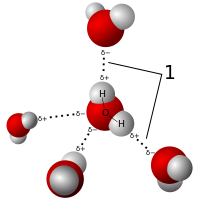
Photo from wikipedia
Reaction discovery and catalyst screening lie at the heart of synthetic organic chemistry. While there are efforts at de novo catalyst design using computation/artificial intelligence, at its core, synthetic chemistry… Click to show full abstract
Reaction discovery and catalyst screening lie at the heart of synthetic organic chemistry. While there are efforts at de novo catalyst design using computation/artificial intelligence, at its core, synthetic chemistry is an experimental science. This review overviews biomacromolecule-assisted screening methods and the follow-on elaboration of chemistry so discovered. All three types of biomacromolecules discussed─enzymes, antibodies, and nucleic acids─have been used as "sensors" to provide a readout on product chirality exploiting their native chirality. Enzymatic sensing methods yield both UV-spectrophotometric and visible, colorimetric readouts. Antibody sensors provide direct fluorescent readout upon analyte binding in some cases or provide for cat-ELISA (Enzyme-Linked ImmunoSorbent Assay)-type readouts. DNA biomacromolecule-assisted screening allows for templation to facilitate reaction discovery, driving bimolecular reactions into a pseudo-unimolecular format. In addition, the ability to use DNA-encoded libraries permits the barcoding of reactants. All three types of biomacromolecule-based screens afford high sensitivity and selectivity. Among the chemical transformations discovered by enzymatic screening methods are the first Ni(0)-mediated asymmetric allylic amination and a new thiocyanopalladation/carbocyclization transformation in which both C-SCN and C-C bonds are fashioned sequentially. Cat-ELISA screening has identified new classes of sydnone-alkyne cycloadditions, and DNA-encoded screening has been exploited to uncover interesting oxidative Pd-mediated amido-alkyne/alkene coupling reactions.
Journal Title: Chemical reviews
Year Published: 2022
Link to full text (if available)
Share on Social Media: Sign Up to like & get
recommendations!